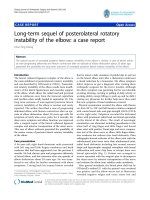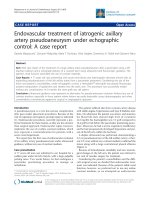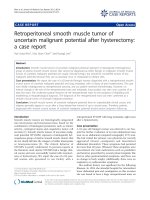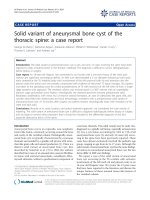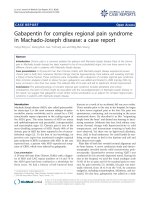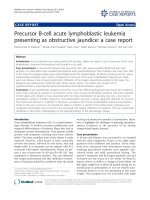Báo cáo y học: " Pancreatitis with an unusual fatal complication following endoscopic retrograde cholangiopancreaticography: a case report" ppt
Bạn đang xem bản rút gọn của tài liệu. Xem và tải ngay bản đầy đủ của tài liệu tại đây (416.7 KB, 4 trang )
BioMed Central
Page 1 of 4
(page number not for citation purposes)
Journal of Medical Case Reports
Open Access
Case report
Pancreatitis with an unusual fatal complication following
endoscopic retrograde cholangiopancreaticography: a case report
Boris L Kanen and Ruud JLF Loffeld*
Address: Department of Internal Medicine, Zaans Medisch Centrum, Zaandam, The Netherlands
Email: Boris Kanen - ; Ruud JLF Loffeld* -
* Corresponding author
Abstract
Introduction: Endoscopic retrograde cholangiopancreaticography has been the treatment of
choice for stones in the common bile duct. Although the procedure is usually safe, procedure-
related complications do occur.
Case presentation: A case of pancreatitis following endoscopic retrograde
cholangiopancreaticography is described in a 55-year-old woman. After an uneventful recovery the
patient's condition deteriorated rapidly 16 days after the endoscopic retrograde
cholangiopancreaticography, and the patient died within 1 hour. Post-mortem examination
revealed massive intrapulmonary fat embolism. The complications of endoscopic retrograde
cholangiopancreaticography and pancreatitis are described.
Conclusion: Fat embolism can occur after the remission of pancreatitis and pancreatic necrosis
may be overlooked on contrast-enhanced computed tomography scanning.
Introduction
Endoscopic retrograde cholangiopancreaticography
(ERCP) has been the treatment of choice for stones in the
common bile duct. Although the procedure is usually safe,
procedure-related complications do occur, the most seri-
ous of which are perforation, bleeding and pancreatitis.
Pancreatitis can take a complicated course. Necrotising
pancreatitis, pseudocysts, pancreatogenic ascites and
infection have been reported. Systemic complications
leading to multi-organ failure are the usual cause of death
in cases of pancreatitis. However, post-ERCP pancreatitis
is usually mild and self-limiting.
A patient with post-ERCP pancreatitis is described. During
reconvalescence the patient developed a very rare second-
ary complication related to pancreatitis.
Case presentation
A 55-year-old woman visited our clinic because of typical
biliary colic. She had undergone cholecystectomy because
of symptomatic gallstone disease 3 years earlier. For the
last 6 months she had suffered from intermittently occur-
ring colic. The pain was located in the right upper quad-
rant of the abdomen. The patient identified the complaint
as being the same pain as she had experienced prior to the
cholecystectomy. The colic was triggered by ingestion of
fat. The patient also noted short periods of discoloured
stools and dark urine without jaundice. In addition, the
patient had classical reflux complaints with heartburn and
acid regurgitation.
Laboratory investigations did not show any signs of
cholestasis: aspartate aminotransferase (ASAT) 15 U/l
(normal value 10 to 40 U/l), alanine aminotransferase
Published: 24 June 2008
Journal of Medical Case Reports 2008, 2:215 doi:10.1186/1752-1947-2-215
Received: 2 July 2007
Accepted: 24 June 2008
This article is available from: />© 2008 Kanen and Loffeld; licensee BioMed Central Ltd.
This is an Open Access article distributed under the terms of the Creative Commons Attribution License ( />),
which permits unrestricted use, distribution, and reproduction in any medium, provided the original work is properly cited.
Journal of Medical Case Reports 2008, 2:215 />Page 2 of 4
(page number not for citation purposes)
(ALAT) 17 U/l (normal value 5 to 45 U/l), alkaline phos-
phatase 59 U/l (normal value 40 to 120 U/l) and bilirubin
9 μmol/l (normal value 1 to 15 μmol/l). However, an
ultrasound investigation of the upper abdomen showed a
slightly dilated common bile duct of 8 mm, with signs of
small stones. Owing to the reflux complaints, an upper
gastrointestinal endoscopy was performed. A hiatus her-
nia with reflux oesophagitis grade III according to Savary
and Miller was diagnosed. It was decided that the patient
should be treated with pantoprazol 40 mg daily. An ERCP
was performed 4 weeks later. During this period there
were no changes in the clinical condition with the excep-
tion of complete remission of the reflux complaints. A
normal major papilla was seen. The pancreatic duct was
normal. Despite several attempts it was not possible to
gain access to the common bile duct. As the common bile
duct was dilated it was decided to perform a precut papil-
lotomy with the needle knife. Despite several attempts the
common bile duct could not be cannulated and at that
point the procedure was terminated.
Several hours later the patient complained of increasing
pain in the upper part of her abdomen. The abdomen was
tender with an absence of peristalsis. Examination of the
blood revealed a serum amylase of 1142 U/l (normal
value 60 to 220 U/l), ASAT of 1142 U/l (normal value 10
to 40 U/l), ALAT of 1220 U/l (normal value 5 to 45 U/l),
alkaline phosphatase of 131 U/l (normal value 40 to 120
U/l) and γGT of 392 U/l (normal value 5 to 35 U/l). There
was a leukocytosis of 15.6 × 10
9
/litre. An X-ray of the
abdomen showed air in the retroperitoneal space. The
clinical diagnosis was post-ERCP pancreatitis with perfo-
ration due to the precut papillotomy.
Computed tomography (CT) scanning with contrast
enhancement 2 days later showed a right-sided pleural
effusion and a collection of air in the retroperitoneal
space. The head and corpus of the pancreas were normal;
some infiltration in the region of the tail of the pancreas
was seen. There was no necrosis. The common bile duct
was dilated with a diameter of 1 cm.
The liver enzymes and hyperamylasaemia returned to nor-
mal within 3 days. On account of persisting leukocytosis
and a body temperature of 38.3°C antibiotic therapy was
started (cefuroxim and metronidazole). Blood cultures
were negative. Enteral feeding via a tube in the proximal
jejunum was started. Eight days after the onset of the pan-
creatitis the patient again developed fever (39.5°C) with-
out obvious explanation. Blood investigations still
showed a leukocytosis (17.3 × 10
9
/ml), with an acute
phase reaction (elevation of the erythrocyte sedimenta-
tion rate and C-reactive protein). This time blood culture
was positive for Pseudomonas aeruginosa. Antibiotic ther-
apy was changed to ciprofloxacin. Her body temperature
became subfebrile.
A CT scan taken 7 days later showed normalisation of the
pancreas. The infiltration in the tail of the pancreas had
almost subsided and the retroperitoneal air had disap-
peared. There was still pleural effusion and some ascites
present. The clinical condition of the patient further
improved, the fever disappeared and the abdomen was
non-tender. The patient had normal stools. The treatment
with opioids was tapered and normal oral feeding was
started.
Sixteen days after the ERCP, when discharge of the patient
was already being considered, her clinical condition dete-
riorated acutely. The patient became dyspnoeic, anxious
and tachycardic, with a drop in blood pressure. Blood gas
analysis showed respiratory alkalosis with hypoxaemia.
Acute pulmonary embolism was suspected and treatment
with anticoagulant therapy was started. Electrocardiogra-
phy showed tachycardia with no signs of acute embolism
or myocardial infarction. Cardiac ultrasound did not
show signs of infarction or high pressures in the right side
of the heart. The clinical situation worsened over the next
30 minutes. Ventricular tachycardia developed, respira-
tory arrest occurred and despite resuscitation the patient
died within 1 hour.
Post-mortem examination showed no signs of acute myo-
cardial infarction or pulmonary embolism. Both lungs
showed signs of congestion compatible with the resuscita-
tion. There was pleural fluid present. The culture was ster-
ile. The pancreas showed signs of necrosis in the head and
tail. There was fat necrosis in the retroperitoneum. No
abscesses were seen. There were no signs of recent local
bleeding. The common bile duct was dilated but there
were no signs of stones in the common bile duct. A perfo-
ration opening at the level of the papilla was not detected.
Two litres of ascites were present. There were no signs of
systemic septicaemia, despite the fact that culture of the
intra-abdominal fluid was positive for Enterococcus faeca-
lis. Macroscopic examination was unable to identify any
direct cause of death. Revision of the final CT scan did not
reveal signs of necrosis.
Histological examination of the pancreas showed normal
pancreatic tissue as well as areas with fatty necrosis. How-
ever, histological examination of sections of the lungs
showed signs consistent with massive intrapulmonary fat
embolism (Figures 1 and 2). The final diagnosis was death
due to massive intrapulmonary fat embolism which
occurred 16 days after the onset of a post-ERCP pancreati-
tis.
Journal of Medical Case Reports 2008, 2:215 />Page 3 of 4
(page number not for citation purposes)
Discussion
This case report clearly highlights two important issues:
first, the potential risk of ERCP, especially when precut
papillotomy is applied; and, second, the occurrence of a
very rare complication of pancreatitis late in the course of
this disease.
The incidence of post-ERCP pancreatitis is reported as
ranging from 1.3% to 6.7% [1]. There are also studies with
an incidence of up to 24% [1]. The varying incidence of
post-ERCP pancreatitis depends either on the case mix or
the criteria used for defining pancreatitis. Pancreatitis and
high serum amylase usually occur after difficult proce-
dures in which pancreatography was achieved [2]. Small
common bile ducts and precut papillotomy also signifi-
cantly increase the risk of pancreatitis [2]. An age of less
than 59 years, opacification caused by instillation of radi-
ographic contrast in the pancreatic duct and the absence
of common bile duct stones appear to be independent
predictors of post-ERCP pancreatitis [3]. Pancreatitis
occurs in patients with younger median age and more
often in women [2]. The complication can also occur
without cannulation and opacification of the pancreatic
duct.
The precut technique is performed after the failure of mul-
tiple cannulation attempts. Although the precut proce-
dure is reported to be safe [4], it can increase the
complication rate of the procedure and should be
restricted to cases in which endoscopic intervention is
mandatory [5]. This is the case in patients with dilatation
of the bile ducts, jaundice, cholangitis or itching due to
obstructive jaundice. The case described here had all of
the signs of stones in the common bile duct with the
exception of laboratory abnormalities. Post-ERCP pancre-
atitis usually has a good prognosis, and most patients can
be discharged within 5 days [6].
Pancreatitis can be a serious condition, and systemic com-
plications in particular add to morbidity and mortality.
Fat embolism is reported as a very rare complication. Spo-
radic cases are reported, mostly in older literature. Fat
embolism usually occurs at the onset of the pancreatitis
[7,8].
Fat embolism is a well-known complication of fractures of
long bones and bone surgery. Fat droplets in small vessels
may be derived from the bone marrow or from plasma by
agglutination of chylomicrons or by infusion of exoge-
nous fat. This can result in vascular occlusion and infarc-
tion. Free fatty acids have a direct toxic effect on
endothelial cells and pneumocytes, resulting in capillary
leakage and loss of surfactant, and the formation of hya-
line membranes.
Classical fat embolism is characterised by the triad of res-
piratory distress, mental disturbances and petechial skin
rash occurring 12 to 72 hours after the initial incident
responsible for the fat embolism. The pulmonary fat
embolism syndrome exists as a spectrum, from embolism
of fat without clinical symptomatology to the full-blown
syndrome with a mild or even fulminant presentation.
Fat embolism has also been described in cases of pancre-
atitis, diabetes, lipectomy, lipid hyperalimentation and
sickle cell disease. Chylomicron and very low-density
lipoprotein (VLDL) have been shown to develop calcium-
Haematoxylin and eosin stain of a section of the lungs show-ing a blood vessel with fibrinoid material and an optical empty space indicative of the presence of lipid dissolved dur-ing the staining processFigure 1
Haematoxylin and eosin stain of a section of the lungs show-
ing a blood vessel with fibrinoid material and an optical
empty space indicative of the presence of lipid dissolved dur-
ing the staining process.
The phenomenon shown in Figure 1 at a higher magnificationFigure 2
The phenomenon shown in Figure 1 at a higher magnification.
Publish with BioMed Central and every
scientist can read your work free of charge
"BioMed Central will be the most significant development for
disseminating the results of biomedical research in our lifetime."
Sir Paul Nurse, Cancer Research UK
Your research papers will be:
available free of charge to the entire biomedical community
peer reviewed and published immediately upon acceptance
cited in PubMed and archived on PubMed Central
yours — you keep the copyright
Submit your manuscript here:
/>BioMedcentral
Journal of Medical Case Reports 2008, 2:215 />Page 4 of 4
(page number not for citation purposes)
dependent agglutination by C-reactive protein in acute
pancreatitis [7]. Fat embolism in the course of acute pan-
creatitis has been described previously [8]. The condition
can also occur in the eye, resulting in temporary loss of
vision [9,10].
Chest radiography may show a snowstorm pattern in 30%
to 60% of patients. Our patient only had pleural effusion
on previous X-ray examination of the thorax, and there
was no opportunity for repeated radiographic examina-
tion of the lungs. This may be an indication of the acute
onset of massive lethal fat embolism.
Cerebral infarction due to fat embolism in the course of
traumatic pancreatitis more than 2 weeks after the acci-
dent has been described previously [11]. Our patient
developed acute massive pulmonary fat embolism more
than 2 weeks after the onset of pancreatitis. This compli-
cation was unusual given the fact that the patient had
improved remarkably and was almost ready for discharge.
The contrast-enhanced CT scan revealed no signs of pan-
creatic necrosis. However, the autopsy clearly showed
necrosis in the pancreas, although not in the head of the
pancreas. It is reasonable to assume that this necrosis trig-
gered the fat embolism.
Conclusion
This case demonstrates that fat embolism can occur after
the remission of pancreatitis and shows that pancreatic
necrosis may be overlooked on contrast-enhanced CT
scanning.
Abbreviations
ALAT: alanine aminotransferase; ASAT: aspartate ami-
notransferase; CT: computed tomography; ERCP: endo-
scopic retrograde cholangiopancreaticography; VLDL:
very low-density lipoprotein.
Competing interests
The authors declare that they have no competing interests.
Consent
Written informed consent could not be obtained in this
case since the patient's next-of-kin were untraceable. We
believe this case report contains a worthwhile clinical les-
son which could not be as effectively made in any other
way. We expect the patient's next-of-kin not to object to
the publication since every effort has been made so the
patient remains anonymous.
Authors' contributions
BK was the attending physician and RL was the consultant
gastroenterologist. Both authors have read and approved
the final version of the manuscript.
References
1. Testoni PA: Why the incidence of post-ERCP pancreatitis var-
ies considerably? Factors affecting the diagnosis and the inci-
dence of this complication. JOP 2002, 3:195-201.
2. Dickinson RJ, Davies S: Post-ERCP pancreatitis and hyperamy-
lasaemia: the role of operative and patient factors. Eur J Gas-
troenterol Hepatol 1998, 10:423-428.
3. Mehta SN, Pavone E, Barkun JS, Bouchard S, Barkun AN: Predictors
of post-ERCP complications in patients with suspected
cholodocholithiasis. Endoscopy 1998, 30:457-463.
4. Rabenstein T, Ruppert T, Schneider HT, Hahn EG, Ell C: Benefits
and risks of needle-knife papillotomy. Gastrointest Endosc 1997,
46:207-211.
5. Pereira-Lima JC, Rynkowski CB, Rhoden EL: Endoscopic treat-
ment of choledocholithiasis in the era of laparoscopic chole-
cystectomy: prospective analysis of 386 patients.
Hepatogastroenterology 2001, 48:1271-1274.
6. Enns R, Eloubeidi MA, Mergener K, Jowell PS, Branch MS, Pappas TM,
Baillie J: ERCP-related perforations: risk factors and manage-
ment. Endoscopy 2002, 34:293-298.
7. Hulman G: Pathogenesis of non-traumatic fat embolism. Lan-
cet 1988, 1:1366-1367.
8. Guardia SN, Bilbao JM, Murray D, Warren SE, Sweet J: Fat embo-
lism in acute pancreatitis. Arch Pathol Lab Med 1989,
113:503-506.
9. Flaggl E, Heer M, Hany A, Branda L: Loss of vision as a complica-
tion of acute pancreatitis. Schweiz Med Wochenschr 1988,
14:722-725.
10. Hackelbusch R: Fat embolism of retinal arteries following
acute pancreatitis. Klin Monatsbl Augenheilkd 1984, 185:50-52.
11. Bhalla A, Sachdev A, Singh Lehl S, Singh R, D'Cruz S: Cerebral fat
embolism as a rare possible complication of traumatic pan-
creatitis. JOP 2003, 4:155-157.
